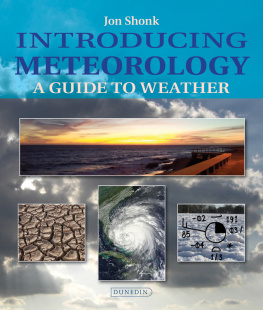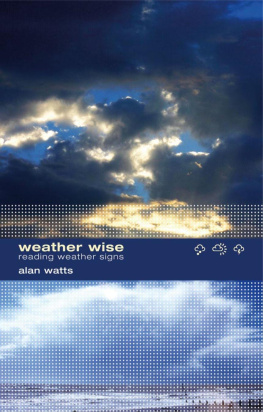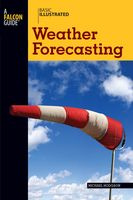Introducing
Meteorology
Companion titles
Introducing Geology A Guide to the World of Rocks (Second Edition 2010)
Introducing Palaeontology A Guide to Ancient Life (2010)
Introducing Volcanology A Guide to Hot Rocks (2011)
Introducing Geomorphology A Guide to Landforms and Processes (2012)
Introducing Tectonics, Rock Structures and Mountain Belts (2012)
Introducing Oceanography (2012)
For further details of these and other Dunedin Earth and Environmental Sciences titles see: www.dunedinacademicpress.co.uk

ISBN 978-1-906716-21-9

ISBN 978-1-906716-15-8
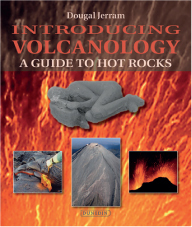
ISBN 978-1-906716-22-6
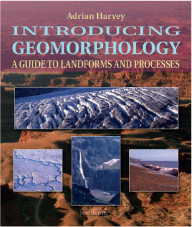
ISBN 978-1-906716-32-5

ISBN 978-1-906716-26-4

ISBN 978-1-78046-001-7
Introducing
Meteorology
A Guide to Weather
Jon Shonk

First published in 2013 by
Dunedin Academic Press Ltd
Head Office: Hudson House,
8 Albany Street, Edinburgh EH1 3QB
London Office: The Towers,
54 Vartry Road, London N15 6PU
Paperback book: 9781780460024
ePub: 9781903544570
ePub (Amazon/Kindle): 9781903544747
ePub (iPad, Fixed Layout): 9781903544754
Jon Shonk 2013
The right of Jon Shonk to be identified as the author of this work has been asserted by him in accordance with sections 77 and 78 of the Copyright, Designs and Patents Act 1988
All rights reserved.
No part of this publication may be reproduced or transmitted in any form or by any means or stored in any retrieval system of any nature without prior written permission, except for fair dealing under the Copyright, Designs and Patents Act 1988 or in accordance with the terms of a licence issued by the Copyright Licensing Society in respect of photocopying or reprographic reproduction. Full acknowledgement as to author, publisher and source must be given. Application for permission for any other use of copyright material should be made in writing to the publisher.
British Library Cataloguing in Publication data A catalogue record for this book is available from the British Library
Typeset by Makar Publishing Production, Edinburgh Printed in Poland by Hussar Books
Acknowledgements
First, I wish to thank Ross Reynolds and Pete Inness for encouraging me to write this book their help and support throughout the writing process has been invaluable, as has their willingness to check through various chapters of the manuscript. I also thank Keith Shine for his careful review of Chapter 16, Mike Stroud and Giles Harrison for permitting me to take photos and use data from the Atmospheric Observatory at the University of Reading, and David McLeod and Anne Morton at Dunedin Academic Press for their support and guidance. I must also thank all of the following for agreeing to look through a chapter or two: Lesley Allison, Laura Baker, Andy Barrett, Sylvia Bohnenstengel, Kirsty Hanley, Emma Irvine, Nick Klingaman, Keri Nicoll, Daniel Peake, Ali Rudd, Claire Ryder, Jane Shonk, Peter Shonk, Claire Thompson, Rob Thompson, Andy Turner and Curtis Wood. Finally, I thank all my friends and family for being supportive, and my housemate, Sam Ridout, for constantly reminding me that I should really be writing my book whenever she found me in front of the TV of an evening.
This book is dedicated to the memory of David Grimes.
Figure Credits
Figures 0.1, 11.4, 13.2B, 13.4, 13.8: NASA Earth Observatory.
Figure 1.1: Rachel OByrne.
Figures 1.2, 2.1, 2.2, 3.7ABC, 7.4AB, 7.5, 8.4, 12.1B, 15.5AD: Jon Shonk.
Figures 1.3, 7.7A: Michelle Cain.
Figures 2.3ABCD, 3.2AB, 3.3, 3.4, 3.5AB, 3.6AB, 4.1, 4.2, 8.1, 10.9: courtesy of the Department of Meteorology, University of Reading.
Figure 2.4: NOAA Photo Library/US Weather Bureau.
Figures 2.5, 2.6: NOAA Photo Library.
Figure 2.7: US Army Photo.
Figures 3.1, 8.7, 9.7AB, 15.1, 15.2: European Centre for Medium-Range Weather Forecasts (ECMWF).
Figures 3.7DF, 6.5: Mike Blackburn.
Figure 3.7E: Peter Smith.
Figure 3.8: NOAA (National Data Buoy Center).
Figures 4.3, 4.4, 10.2, 14.1, 15.3: Crown Copyright, Met Office.
Figures 4.7ABC, 10.5, 10.11, 12.2, 13.2A: NEODAAS/University of Dundee.
Figure 5.1: NASA Earth Observatory/JSC Gateway to Astronaut Photography of Earth.
Figure 5.5: Stuart Nock.
Figure 6.6: NOAA Photo Library/Wilson Bentley.
Figure 7.7B: NOAA Photo Library/Grant W Goodge.
Figure 7.8: adapted from Kiehl, JT and Trenberth, KE (1997): Earths Annual Global Mean Energy Budget. Bulletin of the American Meteorological Society, #78, 197208.
Figure 8.5A: Daniel Peake.
Figures 8.5B, 13.5B: John Lawson.
Figure 10.4: adapted from Bjerknes, J and Solberg, H (1922): Life Cycle of Cyclones and the Polar Front Theory of Atmospheric Circulation. Geofysiske Publikationer, #1, 318.
Figure 11.2: NASA Earth Observatory/NOAA.
Figure 11.8: based on Halpert, MS and Ropelewski, CF (1992): Surface Temperature Patterns Associated with the Southern Oscillation. Journal of Climate, #5, 577593; Ropelewski, CF and Halpert, MS (1987): Global and Regional Scale Precipitation Patterns Associated with the El NioSouthern Oscillation. Monthly Weather Review, #115, 1,6061,626.
Figures 12.1A, 13.9: Wagner Nogueira Neto/Ana Carolina Lacorte de Assis.
Figure 12.1C: Robin Hogan.
Figure 12.3: Andy Barrett.
Figure 12.6AB: Robin Tanamachi.
Figure 12.6C: Gerard Devine.
Figure 13.5A: Claire Delsol.
Figure 15.4: NASA Earth Observatory/USGS Earth Observing-1.
Figure 15.5B: Jane Shonk.
Figure 15.5C: Peter Shonk; courtesy of Alec Murray.
Figure 16.1: adapted from Brohan, P; Kennedy, JJ; Harris, I; Tett, SFB and Jones, PD (2006): Uncertainty Estimates in Regional and Global Observed Temperature Changes: a New Data Set from 1850. Journal of Geophysical Research, #111, D12106, DOI: 10.1029/2005JD006548.
Figure 16.2: National Science Foundation, photography by Heidi Roop.
Figure 16.3: adapted from Petit, JR; Jouzel, J; Raynaud, D; Barkov, NI; Barnola, JM; Basile, I; Bender, M; Chappellaz, J; Davis, J; Delaygue, G; Delmotte, M; Kotlyakov, VM; Legrand, M; Lipenkov, V; Lorius, C; Ppin, L; Ritz, C; Saltzman, E and Stievenard, M (1999): Climate and Atmospheric History of the Past 420,000 Years from the Vostok Ice Core, Antarctica. Nature, #399, 42936.
Figure 16.4: Pieter Tans, (NOAA/ESRL) and Ralph Keeling (Scripps Institute of Oceanography).
Figure 16.5: from IPCC Fourth Assessment Report, Figure 3.2.
Preface
Every time we step outdoors, or even look out of the window, we experience weather. Sometimes we are greeted by clear, blue skies; at other times we are faced with grey clouds. On some days, we feel the wind in our faces; on other days it can be completely calm. Some days are warm, some days are cold; some bring rain, some stay dry. Some even bring severe weather heavy snowfall, freezing rain, tornadoes or dust storms. No two days of weather are the same, and the weather is always changing.
Next page
